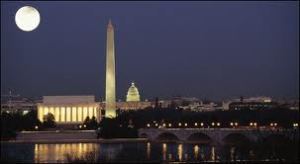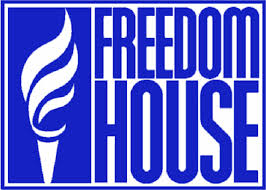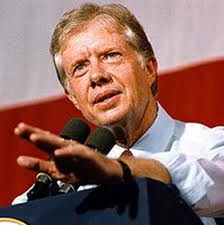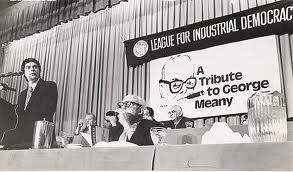http://
From Socialism to Neoliberalism: A Story of Capture (Part 2 of 2)
Kahn Goes to Washington, Rustin Goes to WarOverall, 1972 proved to be a year of change on all fronts. Shachtman passed away and was eulogized by Kahn in the pages of Dissent. Henry Jackson lost the nomination to George McGovern and organized labor, and following the opinion of Bayard Rustin, reverted to supporting the man who had split the left several years earlier, Hubert Humphrey.i On the other hand, Harrington declared his support for the dovish McGovern, the only viable anti-war candidate anywhere on the political spectrum. By all means McGovern should have won the support of labor: he had written his doctoral dissertation on the Ludlow Massacre, and according to the AFL-CIO itself he had voted pro-union 93% of the time.ii But Meany, ever the anti-communist, held far more clout than the average opinion of the worker represented by the federation. In was in context that after Jackson lost out Kahn, at the request of Lane Kirkland, went to work at the AFL-CIO as Meany’s speechwriter.iii
As these rivalries drove irreversible wedges into the various factions of the left, the Socialist Party of America underwent a transformation. At their 1972 convention, the party’s co-chairs, Rustin and Charles Zimmerman (the head of the International Ladies Garment Workers’ Union and the AFL-CIO’s Civil Rights Committee)iv restructured and renamed the organization as the Social Democrats USA (SD/USA). The SD/USA drew its ranks from the AFL-CIO – LID alignment: members included Tom Kahn and Rachelle Horowitz, A. Philip Randolph, Norman Hill, Robert J. Alexander, Albert Shanker, and lesser-known activists such as Carl Gershman, Sandra Felman, Penn and Eugenia Kemble, Joshua Muravchik, Jay Mazur, John T. Joyce, and Adrian Karatnycky. To announce the creation of the new organization, the SD/USA published a pamphlet titled “The American challenge: A social-democratic program for the Seventies.” Dismissing the radicalism of the 1960s, the pamphlet describes the softening views of the organization, beginning with a dismissal of the intellectuals and activists that were critical of Big Labor, and containing allusions to the belief that the U.S. could be an instrument of peace with the ability to promote democracy around the world.v
One of the first acts of the new SD/USA was to launch a counterattack against the peaceniks that they perceived as taking over the Democrat Party, chiefly personified in George McGovern. McGovern’s historic loss to Nixon had created an open space to ‘reclaim’ the Democrats, something that was seen as essential at the dawn of détente. After a LID luncheon Midge Decter, a secretary at the offices of Commentary, and Ben Wattenberg, then serving as Jackson’s chief strategist, conceived of a vehicle for just such an agenda – the Coalition for a Democratic Majority (CDM), an anti-communist, anti-‘New Politics,’ pro-labor consortium.vi For Jackson, it was a platform that he could draw on for another presidential bid in 1976. The SD/USA featured prominently: Penn Kemble was named the executive director, and Bayard Rustin, Carl Gershman, Rachelle Horowitz, Josh Muravchik, Albert Shanker, Norman Hill, and others would follow suit.vii Norman Podhoretz, the editor of Commentary and husband of Decter was also a member,viii as was the intellectual Allen Weinstein,ix Jeane J. Kirkpatrick, future Trilateralist Samuel Huntington, and most of the upper management of the AFL-CIO.x
As this strong bloc formed and solidified the ties between the Jacksonites, the Shachtmanites and labor, Kahn continued to climb the ranks of the AFL-CIO. He became increasingly involved in the federation’s International Affairs division, the longtime homes of Jay Lovestone and Irving Brown, a former organizer for the International Ladies Garment Workers’ Union who had become AFL-CIO’s point man in Europe. Not surprisingly, Brown, like Lovestone, was supplementing his union duties with work for the CIA.xi Kahn situated himself quite nicely in this world in-between organizing and espionage. As Horowitz later recalled, “During this time Tom Kahn helped craft much of the AFL-CIO’s foreign policy and domestic strategy for maintaining a credible anti-communist stance….As editor of the Free Trade Union News, Kahn kept readers abreast of the struggle for democracy and free trade unionism in the communist world.”xii
Rustin’s rise was equally impressive. He joined the boards of both the “who’s who of neoconservatives,” Freedom House, and along with Gershman and Shanker, the International Rescue Committee (IRC). In an evolution similar to that of the Shachtmanites, the organization had originally been formed by socialists and prominent liberal intellectuals (including the militant Reinhold Neibuhr, LID member John Dewey, Jay Lovestone, and Bryn Hovde, a State Department official and president of the New School for Social Research)xiii and had drawn support from the AFL’s David Dubinsky and Freedom House’s founder, Eleanor Roosevelt.xiv The Committee was soon working in tandem with the New School, with ample funding provided by the Rockefeller Foundation, to bring refuged intellectuals from abroad to the United States.xv Before long, however, it would be also be drawing funding from the Ford Foundation, and indirectly, the CIA.xvi Noting that the IRC had also taken an active in the early build-up to the Vietnam War, journalist Robert Scheer had written in 1965 that the humanitarian organization “helped to shape the Cold War as we live it today.”xvii Kahn would also eventually migrate to the IRC board, as did future CIA director William Casey, Henry Kissinger, and Donald Rumsfeld.xviii
As the 1976 elections drew near, the SD/USA-CDM-AFL-CIO network was placed in an awkward position. A Jackson presidency was the desired goal, yet the liberal elite contingencies had already selected their man – Jimmy Carter. In 1972 Carter had thrown his support behind Jackson instead of McGovern, and through the Trilateral Commission had garnered the respect of heavyweights such as David Rockefeller and the hawkish Brzezinski.xix For the former socialists, whose political views where truly all over the map, the prospects of their figurehead in the Oval Office was looking rather dim. Regardless, Jackson launched an attack on the contender at a SD/USA dinner, characterizing Carter as a rightist-in-sheep’s clothing. Referencing the anti-government mottoes in his rival’s campaign, Jackson said “Call it what you will, it represents an attack on the idea that the government can do things to help people… The attacks on big government remind me of the attacks on big labor.”xx Rustin, Kahn, and other SD/USA members had toiled years before on the Freedom Budget, the center piece of which was a federal jobs program, and the stance of Carter seemed counterintuitive to these goals that, despite the hardline stance on foreign policy, continued to linger. Much to their dismay, Jackson eventually lost out to Carter in the primaries.
The CDM reluctantly switched their support to Carter. He was, in many respects, in agreement with the majority of the coalition’s views: he was extremely anti-communist, he had supported the Vietnam War, and he had garnered the endorsement of the Israeli lobby. However, after the elections they were locked out from any policy positions save for Peter Rosenblatt, who was given a job in faraway Micronesia. Elliot Abrams bemoaned what the organization saw as a betrayal. “They froze us out completely,” he said. “They froze us out completely. It was a special negotiator position. Not for Polynesia. Not even for Macronesia. But for Micronesia.”xxi In return for the actions, the CDM-SD/USA launched a counterattack on the new president. When it was reported that Carter was going to announce Paul Warnke, an old associate of George McGovern, as a potential candidate to head up the arms negotiation, the CDM saw an opening. Penn Kemble and Joshua Muravchik drafted and circulated an anonymous memo charging that Warnke sought to undermine the US’s military deterrence by calling for “unilateral abandonment by the US of every weapons system that is subject to negotiations at SALT.”xxii
These events helped to push the network further rightward, and the intricate ties they continued to establish reflected this mentality. During the latter days of Gerard Ford’s presidency, CIA director George H.W. Bush launched “Team B,” a private team of intellectuals, military analysts, and public servants tasked with evaluating the CIA’s intelligence reports on the Soviet Union.xxiii The group, whose members included the old Rockefeller ally Paul Nitze and Jackson’s staffer Paul Wolfowitz, launched a vicious attack on the agency; their consensus was that the CIA, much akin to the reconciliatory tone of much of the Washington establishment, was severely underestimating the Soviet threat. Even after their tenure ended, the team continued to beat their war drums by creating the Committee on the Present Danger (CPD).
The CPD, essentially a pro-war lobbying organization brimming with neoconservative interests, utilized the CDM as their primary base of support. Bayard Rustin and Lane Kirkland took positions in the committee, joined by Jeane Kirkpatrick, Albert Shanker, Rachelle Horowitz, Jay Lovestone, and the AIFLD’s J. Peter Grace. Major business interests also populated the organization – representatives from the RAND Corporation, Goldman Sachs, and Honeywell rubbed shoulders with the former peace activists. If Jackson had been the trigger for the SD/USA’s alignment with the military-industrial complex, the CPD was the ultimate culmination of the evolution: start-up funding was provided by David Packard of Hewlett Packard fame. Packard stood much to gaining from derailing the SALT mentality, as it limited production of antiballistic missiles (AMB); his company was the primary manufacturer of AMB guidance chips.xxiv
Membership in the CPD not only indicated a partnership with military industrial interests, but their further integration into the upper levels of the political establishment. The AFL-CIO had long been the main linkage, but now a direct access to the policy-making network had been created:
Among the most prominent members and directors [of the CPD] are ex-President Ronald Reagan, David Packard, Nathan Glaser, Saul Bellow, and President George Bush. Moreover, the CPD has director interlocks with many very central upper class policy making and consensus building organizations including the Trilateral Commission, the Atlantic Council, the Brookings Institution board of trustees, the Business Roundtable, the Business Council, the Committee for Economic Development, and the Council on Foreign Relations. Many directors such as David Packard, C. Douglas Dillon, and John T. Connor hold positions on several of these policy groups.xxv
Even though the SD/USA took an adversarial stance to the Carter presidency, the CPD provided them with a direct line to the more hard-lined members of his administration. CDM member Samuel Huntington had been brought in the National Security Council where he worked under Brzezinski, and he would meet with the CPD’s executive committee to keep them abreast of weapons development and the progress of arms negotiations.xxvi Concurrent with this entry into the unofficial channels of governance, the small cabal’s commitment to alternative economics was finally beginning to wane. Rustin, Bayard, Kemble, and the ex-Marxist intellectual Sidney Hookxxvii teamed up to published an essay in Commentary titled “Capitalism, Democracy and Socialism.” In it they wrote that “The idea that there may an inescapable connection between capitalism and democracy has recently begun to seem plausible to a number of intellectuals who would once have regarded such a view as not only wrong but even as politically dangerous.” This “inescapable conclusion,” the former socialists conceded, “often begins more as a rejection of totalitarianism than as a positive endorsement of capitalism.”xxviii
In 1978 Kirkland succeeded Meany as president of the AFL-CIO, and like his longtime mentor, continued to utilize the federation in mobilizing forces against communism abroad. He appointed Irving Brown as the official head of the International Affairs Department. Brown, however, had been stationed in the AFL-CIO’s Paris offices for several years, and was reluctant to leave France for Washington. A compromise was reached, and Kahn was placed in charge as his representative in the capital.xxix It was a major move for Kahn, bestowing him with a larger degree of influence on the anti-Left counterinsurgency worldwide than he ever had before. He moved the union to work closely with Freedom House, where Rustin had set up camp, in protesting the US’s wavering stance on human rights at the Helsinki Accords. He also set up the Free Trade Union Institute (FTUI) to better streamline the AFL-CIO’s overseas operation. The FTUI would work directly under the International Affairs Department, which Kahn had come to envision “as the center of a web of policy and program committee[s] and institutes.”xxx
It had been a long road for Kahn and his colleagues – they had travelled from the underground world of student activism to the highest levels of the Cold War, from the picket lines to a place populated by intelligence agencies and other shadowy entities. The transition for Rustin itself is remarkable. He had done his time as the general secretary of the War Resister’s League, and within a decade and a half was a member of the Committee on the Present Danger – a virtual front organization for defense contractors lining up at the money trough of a government fueled by Cold War paranoia. Socialism had given way to neoconservative, but it also marked something important – the influx of alternative ideas into foreign policies. The benefits of capital-directed humanitarianism had collapsed into dictatorship in Chile, but the AFL-CIO, working with the CIA, had spent the 1970s adjusting its approach to progressive-style anti-communism. With the Reagan administration just around the door, this quasi-Wilsonian methodology was rapidly becoming a contender for the centerpiece of American foreign policy, something to replace the disenfranchisement from both above and below in the wake of the Vietnam War.
i Maurice Isserman The Other America: The Life of Michael Harrington Scriber, 1997 pg. 297
ii Ibid, pg. 298
iii Ibid
iv Gerald Sorin, The Prophetic Minority: American Jewish Immigrant Radicals, 1880-1920 Indiana University Press, 1985, pg. 155
v “The American challenge: A social-democratic program for the seventies” Social Democrats USA/Young People’s Socialist League, December 1972
vi Richard D. Kahlenberg Tough Liberal: Albert Shanker and the Battles Over Schools, Unions, Race, and Democracy Columbia University Press, 2009 pg. 193
vii Ibid
viii Andrew Cockburn Rumsfeld: His Rise, Fall, and Catastrophic Legacy Scribner, 2011 pg. 42
ix Sara Diamond Road to Dominion: Right Wing Movements and Political Power and the United States Guilford Press, 1995 pg. 385, note 113
x J. Richard Piper Ideologies and Institutions Rowman and Littlefield Publishers, 1997 pg. 205
xi Hugh Wilford The CIA, the British Left and the Cold War: Calling the Tune? Routledge, 2003, pg. 39
xii Horowitz “Tom Kahn and the Fight for Democracy”
xiii Andrew F. Smith Rescuing the World: The Life and Times of Leo Cherne State University of New York Press, 2002 pg. 42
xiv Eric Thomas Chester Covert Networks: Progressives, the International Rescue Committee, and the CIA M E Sharp, Inc, 1995 pg. 14-15
xv Peter M. Rutkoff, William B. Scott New School: A History of the New School for Social Research The Free Press, 1986 pgs. 129-130
xvi Ibid, pgs. 50-53
xvii Robert Scheer and Warren Hinckle,”The `Vietnam Lobby” Ramparts, July 1965
xviii
Letter from Robert P. DeVecchi (executive director of the IRC), Dec 6,
1988, cited in Dorienne Truskoff Miner,”The Covert Use of Refugees,” Aug
25, 1987
xix Steven F. Hayward The
Real Jimmy Carter: How Our Worst Ex-President Undermines American
Foreign Policy, Coddles Dictators and Created the Party of Clinton and
Kerry Regnery Publishers Inc., 2004 pgs. 60-61
xx Kahlenberg Tough Liberal pg. 200
xxi Tevi Troy Intellectuals and the American Presidency: Philosophers, Jesters, or Technicians? Rowman and Littlefield Publishers, 2003 pg. 175
xxii Jerry Wayne Sander Peddlers of Crisis: The Committee on the Present Danger and the Politics of Containment South Press End, 1999 pgs. 204-205
xxiii Steven F. Hayward The Age of Reagan: 964-1980: The Fall of the Old Liberal Order Prima Lifestyle, 2001 pg. 424
xxiv Peter Dale Scott The Road to 9/11: Wealth, Empire, and the Future of America University of California Press, 2007, pg. 59
xxv John Boies and Nelson A. Pichardo “The Committee on the Present Danger: A Case for the Importance of Elite SocialMovement Organizations” Berkley Journal of Sociology March, 1990
xxvi Brian J. Auten Carter’s Conversion: The Hardening of American Defense Policy University of Missouri, 2008 pg. 165
xxvii Sidney
Hook, years earlier, had assisted in the creation of the Congress for
Cultural Freedom (CCF), a progressive anti-Communist organization based
in West Berlin. Assisting Hook were various luminaries including the
LID’s John Dewey, Irving Kristol, Fabian socialist Bertrand Russell, and
State Department icon Arthur Schlesinger. In was in the mid-1960s that
the CCF was revealed as being intimately tied to the corridors of
intelligence agency; its primary funders were, in fact, the Ford
Foundation and the CIA. Joshua Muravchik Exporting Democracy pg. 125; Chester Covert Network pg. 52
xxviii Sidney Hook, Bayard Rustin, Carl Gershman, Penn Kemble “Capitalism, Democracy and Socialism” Commentary April, 1978 pp. 29–71
xxix Rachel Horowitz “Tom Kahn and the Fight for Democracy”
xxx Ibid





No comments:
Post a Comment